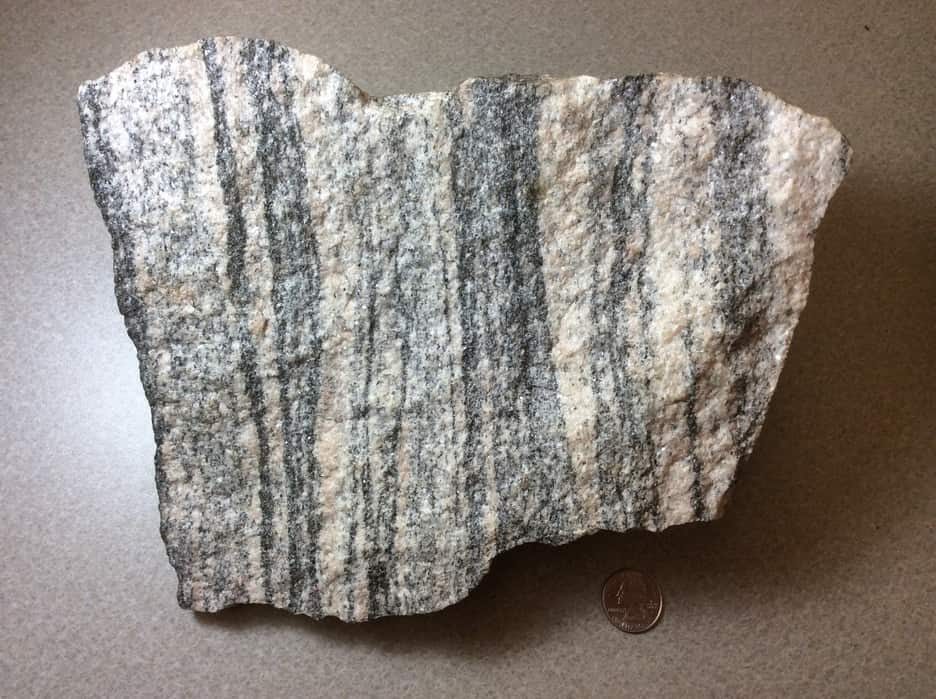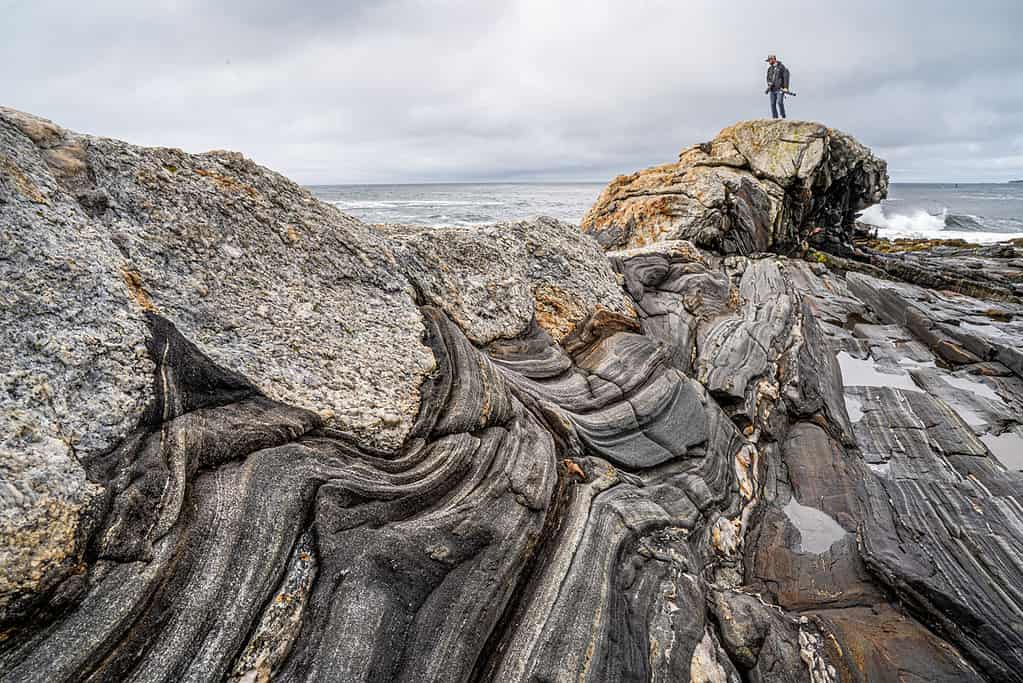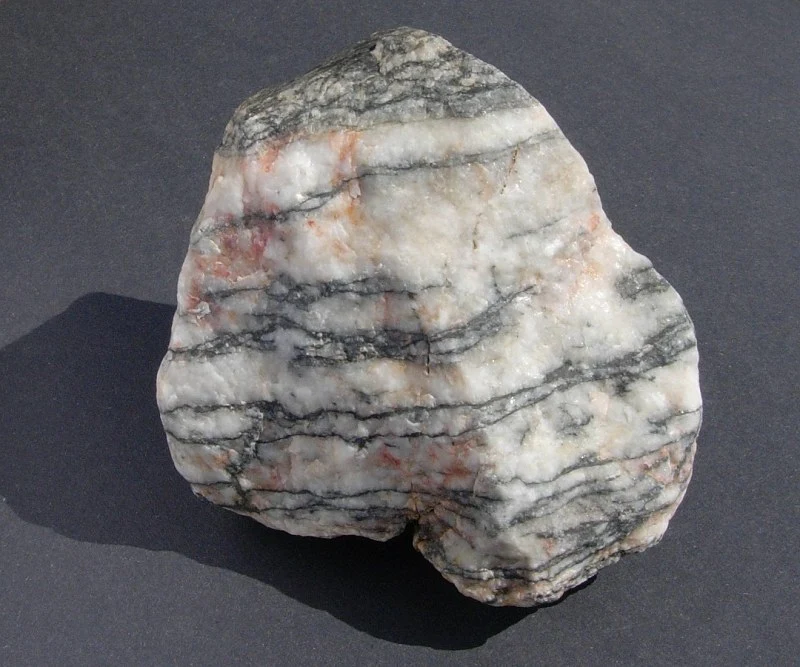
Gneiss (pronounced mostly like “nice”) is a fascinating and widely distributed type of high grade metamorphic rock. This type of rock has a number of distinguishing features that make it a staple in geology. Let’ss explore them.
What is Gneiss?
Gneiss is a prominent type of metamorphic rock, distinguished by its pronounced and intricate banding patterns. This banding results from the alignment of mineral grains under extreme conditions of pressure and temperature. Gneiss is formed through the metamorphic transformation of existing igneous or sedimentary rocks, fundamentally altering the rock’s original structure and composition.
Gneiss is classified as a high-grade metamorphic rock due to the intense heat and pressure conditions required for its formation. Originating from pre-existing rocks such as granite or shale, gneiss undergoes profound physical and chemical changes at temperatures often exceeding 600°C and under significant pressures. This metamorphic process, which is deeper and more intense than that for lower-grade metamorphic rocks, reorganizes the mineral crystals within the rock into distinct bands or layers, a texture known as foliation.
Formation and Composition of Gneiss

Gneiss is formed from the metamorphic alteration of pre-existing igneous or sedimentary rocks under extreme conditions of heat and pressure, typically found deep within the Earth’s crust. Such conditions are also often found at convergent plate boundaries, where tectonic forces play a crucial role in the rock cycle.
The journey of a rock transforming into gneiss begins when it is subjected to temperatures typically above 600°C and pressures between 2 to 24 kbar — that’s 2,000 to 24,000 times the atmospheric pressure. These conditions are often associated with tectonic activities such as continental collisions and subduction zones. Under these intense conditions, the original rock, known as the protolith, undergoes profound physical and chemical changes.
The key process in the formation of gneiss is recrystallization, where minerals within the protolith become unstable and reorganize to form new minerals that are stable under higher pressure and temperature. This process also leads to the segregation of minerals into bands, a characteristic feature of gneiss. Lighter bands, formed mainly of felsic minerals like quartz and feldspar, alternate with darker bands, which are typically composed of mafic minerals such as biotite, amphibole, or garnet.
What gneiss is made from
The chemical and mineral composition of gneiss is highly variable and largely depends on the composition of the original rock. If the protolith is granite, an igneous rock, the resulting gneiss (termed orthogneiss) is rich in quartz and feldspar. If the protolith is a sedimentary rock like shale, the resultant gneiss (known as paragneiss) often contains a higher proportion of mafic minerals.
The specific conditions of pressure and temperature play a crucial role in determining the mineral composition and texture of gneiss. Higher pressures tend to produce more alignment and segregation of minerals, enhancing the banding effect. The temperature influences the size and shape of the mineral grains; higher temperatures typically lead to the growth of larger grains, giving gneiss its coarse-grained texture.
The formation of gneiss is not an overnight phenomenon but a process that unfolds over millions of years. This extended timeframe allows for the gradual reorganization of minerals and the development of the distinctive banded texture.
Types of Gneiss
Gneiss is a highly diverse rock, with several types classified based on their origin, mineral composition, and textural features. This diversity reflects the varied conditions under which gneiss forms and the different parent rocks from which it can originate.
Orthogneiss
Orthogneiss is derived from igneous rocks such as granite or diorite. The term “ortho” refers to its igneous origin. During the metamorphic process, the original igneous structures are obliterated, and new minerals might form, giving the rock its characteristic banded appearance. Orthogneiss often retains traces of its igneous history, such as the remnants of igneous textures or mineral assemblages.
Paragneiss
Paragneiss originates from sedimentary rocks like shale or sandstone. The prefix “para” indicates a sedimentary origin. These rocks are subjected to high-grade metamorphism, causing extensive recrystallization and reorganization of minerals. Paragneiss typically contains a higher proportion of mafic minerals compared to orthogneiss and often includes layers rich in former sedimentary structures like bedding.
Augen Gneiss
This type of rock is named for its distinctive “eye-shaped” mineral grains or “augen” (German for “eyes”). These large, lens-shaped grains, usually feldspar, are surrounded by a matrix of finer-grained minerals. Augen gneiss forms in high-grade metamorphic environments where intense shearing forces are present, causing the deformation of mineral grains into the characteristic eye-like shapes.
Migmatitic Gneiss
Migmatitic gneiss is a complex type where the rock displays characteristics of both metamorphic and igneous processes. It often contains bands or streaks of material that appear melted and recrystallized, resembling igneous rock. These lighter, granitic bands, known as leucosome, are interspersed with darker, more stable areas, the melanosome. This structure suggests partial melting and is indicative of extremely high temperatures — but still not high enough to turn it into an igneous rock.
Granulite Gneiss
Granulite gneiss forms under the highest temperatures and pressures typical of the granulite facies of metamorphism. It is characterized by its granoblastic texture, where minerals form equigranular, interlocking grains without preferred orientation. This type of gneiss often contains pyroxenes and garnets.
Garnet Gneiss, Biotite Gneiss, and Other Mineral-Specific Varieties
Gneiss can also be classified based on the presence of specific minerals. For example, garnet gneiss contains noticeable amounts of garnet, while biotite gneiss is rich in biotite mica. These types are often named after the dominant mineral that characterizes their appearance and composition.
Characteristics of Gneiss

Gneissic Banding
The most defining characteristic of gneiss is its gneissic banding. This banding manifests as alternating layers of light and dark minerals. The lighter bands, typically composed of quartz and feldspar, contrast starkly with the darker bands that contain heavier minerals like biotite, amphibole, or garnet. This banding is not merely superficial but represents the differential segregation and alignment of minerals under high-grade metamorphic conditions.
Coarse-Grained Texture
Gneiss typically exhibits a coarse-grained texture. The individual mineral grains are often large enough to be visible to the naked eye. This texture is a result of the recrystallization process during metamorphism, where new mineral grains grow at the expense of the original minerals in the protolith.
Lack of Foliations
Unlike schist, another common metamorphic rock, gneiss usually does not have a pronounced foliation. While it has a banded appearance, these bands are not typically aligned in a way that imparts a foliated, or leaf-like, structure to the rock. This lack of foliation is due to the high-grade metamorphic conditions under which gneiss forms, where deformation is more about recrystallization and less about realignment of minerals into parallel planes.
Structural Variability
Gneiss can exhibit a range of structural variations depending on its formation process and the nature of the original rock. For instance, augen gneiss displays eye-shaped mineral inclusions, while migmatitic gneiss shows evidence of partial melting. These structural variations provide clues about the metamorphic history and the environmental conditions during the formation of the gneiss.
Color Variations
The color of gneiss varies widely, depending on its mineral composition. It can range from predominantly light colors if felsic minerals dominate, to darker shades when mafic minerals are more abundant. The interplay of light and dark bands often gives gneiss a distinctive and visually appealing appearance.
Hardness and Durability
Gneiss is generally hard and resistant to erosion, which is a characteristic of high-grade metamorphic rocks. This hardness makes it a durable material, suitable for various construction and architectural purposes.
How to Identify Gneiss
Identifying gneiss can be straightforward if you know what to look for. Here’s a simplified guide to help you recognize this distinctive rock:
- Look for Banding: Gneiss is characterized by its visible, alternating bands of light and dark minerals. These bands are usually thicker and more distinct than those in other metamorphic rocks.
- Check Grain Size: Gneiss typically has a coarse-grained texture. The individual mineral grains should be visible to the naked eye.
- Observe Color Variations: Gneiss displays a mix of colors, depending on its mineral composition. Look for the interplay of lighter (quartz and feldspar) and darker (biotite, amphibole) minerals.
- Assess for Foliation: Unlike schist, gneiss does not have a well-defined foliation. Its bands are due to the alignment of minerals under high-grade metamorphism.
- Test the Hardness: Gneiss is a hard rock. It should feel solid and be resistant to scratching.
- Consider the Location: Knowing where the rock was found can provide contextual clues. Gneiss is common in areas with a history of high-grade metamorphism.
- Distinguish from Similar Rocks: Gneiss can be confused with schist or granite. Unlike schist, it lacks a silky foliation, and unlike granite, it exhibits a banded texture.
Uses of Gneiss
Building and Architecture: Gneiss is frequently used in construction for foundations, walls, and architectural details. Its strength makes it suitable for structural purposes, while its distinctive banding adds aesthetic value to building facades and interior designs.
Landscaping: In landscaping, gneiss is popular for paving, creating pathways, and as decorative elements in gardens. Its weather resistance is ideal for outdoor applications.
Interior Decoration: This rock is often chosen for countertops in kitchens and bathrooms, thanks to its heat resistance and durability. Polished gneiss is also used in furniture and decorative items like vases and sculptures.
Infrastructure Projects: Gneiss serves as an aggregate in asphalt and concrete for roads, and as a stable material for railroad ballast.
Art and History: Historically, gneiss has been used in monuments, sculptures, and cultural artifacts, showcasing its importance in art and heritage.
Facts about Gneiss
- Some of the oldest rocks on Earth are gneisses, like the Acasta Gneiss in Canada, which dates back to about 4 billion years ago. This highlights gneiss’s role in understanding Earth’s early history.
- Gneiss forms at high temperatures and pressures, typically greater than those required to form schist. This metamorphism usually happens deep within the Earth’s crust or in areas of significant tectonic activity.
- Gneiss can originate from various types of parent rocks (protoliths), including igneous rocks like granite (forming orthogneiss) and sedimentary rocks like shale (forming paragneiss).
- The characteristic banding in gneiss, with alternating lighter and darker layers, results from the segregation of mineral grains under metamorphic conditions. This feature is not only visually striking but also tells a story of the rock’s metamorphic journey.
- The mineral composition of gneiss can vary widely, depending on the original rock and the specific conditions of metamorphism. Common minerals include quartz, feldspar, and biotite, with variations like garnet gneiss or biotite gneiss named after dominant minerals.
- The presence of gneiss in an area can indicate past geological events like mountain building, continental collisions, and deep crustal movements, making it an important rock for geologists studying Earth’s dynamic history.
- Apart from its scientific importance, gneiss also has commercial value. It’s used in construction, landscaping, and as a decorative stone, prized for its durability and unique appearance.
- Gneiss is commonly used in educational settings to illustrate the concepts of metamorphism, mineralogy, and rock cycle, making it a valuable tool for teaching geology.
Conclusions
Gneiss, with its distinctive features and widespread occurrence, is more than just a rock; it’s a geological marvel that tells the story of Earth’s interior processes. Its study not only helps us understand the history of our planet but also serves practical purposes in our daily lives. Whether you’re a professional geologist, a student, or simply a rock enthusiast, gneiss offers a rich subject for exploration and appreciation.






